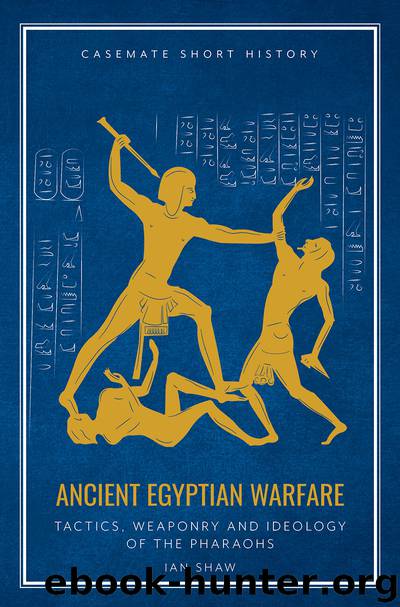Ancient Egyptian Warfare by Ian Shaw

Author:Ian Shaw
Language: eng
Format: epub
Tags: HISTORY / Ancient / Egypt
Publisher: Casemate UK
Published: 2019-11-18T16:00:00+00:00
Rewarding soldiers
Certainly the Egyptian soldier would have undergone enormous physical suffering both in training and in action, but the rich rewards of survival—in the form of personal advancement, spoils of war and gifts of land and livestock upon retirement from military service—would have been some compensation for the survivors of battles and campaigns. The 20th-Dynasty Wilbour Papyrus, mentioned above, is part of the evidence that the state provided for military veterans.
In the early New Kingdom there were important changes not only in the way that the army was organized, but in the role that it played in Egyptian society. On the basis of comparisons between the funerary inscriptions of the 6th-Dynasty official Weni at Abydos and the early 18th-Dynasty soldier Ahmose son of Ibana at Elkab, it has been suggested that there may have been no system of reward for individual soldiers in the Old Kingdom, and that complex systems of recompense might not have been introduced until after the Hyksos period (c.1550 BC onwards), possibly as a direct result of the adoption of Asiatic customs of warfare. Thus, the term sḳr Ꜥnḫ (literally, ‘living captive’) was used indiscriminately in the Old and Middle Kingdoms to refer both to enemies captured on the battlefield and to those taken while plundering defeated settlements, whereas from the late 18th Dynasty onwards it was used specifically to refer to enemy soldiers captured during the battle itself. The term ḥꜣḳt was used to describe people or goods captured only in the course of post-battle plundering, taken to the king and then redistributed as rewards to individual soldiers, and finally the term ḥꜣḳ was used in the 18th Dynasty to designate both objects and people taken in the course of the actual battle and the subsequent plundering.
As with the weaponry, we should beware of suggesting that all changes that emerged in the early 18th Dynasty can be ascribed to contact with the Hyksos. It is equally likely—perhaps more likely—that the adoption of more complex systems of military recompense resulted from increasing Egyptian cultural and economic involvement in Syria-Palestine, and the consequent absorption of the ‘language’ of Asiatic warfare, just as the Egyptians clearly adopted Akkadian as the language of diplomacy by the middle of the 18th Dynasty.
Treatment of the injured and dead
The anthropological evidence for battle in Egypt stretches back at least as far as the 12th millennium BC when struggles between bands of Palaeolithic (Qadan culture, c.12,000 BP) hunter-gatherers led to flint arrowheads becoming embedded in the bones of almost half of the individuals buried in Cemetery 117 at Jebel Sahaba, near Wadi Halfa. A total of 59 human skeletons were excavated at Jebel Sahaba; each of them was in a semi-contracted position on the left side of the body, with the head to the east, facing south.
Out of the 59 individuals found at Cemetery 117, 24 showed signs of a violent death attested either by many chert points embedded in the bones (and even inside the skull) or by the presence of severe cut marks on the bones.
Download
This site does not store any files on its server. We only index and link to content provided by other sites. Please contact the content providers to delete copyright contents if any and email us, we'll remove relevant links or contents immediately.
| Africa | Americas |
| Arctic & Antarctica | Asia |
| Australia & Oceania | Europe |
| Middle East | Russia |
| United States | World |
| Ancient Civilizations | Military |
| Historical Study & Educational Resources |
Black Genesis by Robert Bauval(1603)
Serpent in Sky by John Anthony West(1039)
The Egyptian Book of the Dead by John Romer(820)
The White Nile by Alan Moorehead(778)
100 Hieroglyphs by Barry Kemp(627)
The Emerald Tablets of Thoth the Atlantean by M. Doreal(601)
Nasser by Saïd K. Aburish(574)
Think Like an Egyptian by Barry Kemp(557)
Legends Of The Gods (Illustrated And Annotated Edition) by E. A. Wallis Budge(551)
Lost Technologies of Ancient Egypt: Advanced Engineering in the Temples of the Pharaohs by Dunn Christopher(536)
Egypt - Culture Smart! The Essential Guide to Customs & Culture by Jailan Zayan(526)
Osiris and the Egyptian Resurrection, Vol. 1: 001 by Budge E. A. Wallis(518)
Egyptian Magic (Illustrated And Annotated Edition) by E. A. Wallis Budge(515)
The Ultimate Ambition in the Arts of Erudition by Shihab al-Din al-Nuwayri(509)
The Ultimate Ambition in the Arts of Erudition by al-Nuwayri Shihab al-Din(493)
Egyptian Myths And Mysteries by Steiner Rudolf(478)
Ancient Egyptian Warfare by Ian Shaw(474)
A History of the Middle East: Fourth Edition by Peter Mansfield & Nicolas Pelham(473)
Ramesses by Joyce Tyldesley(460)
